
New Jersey wildfires have become a significant concern in recent years. These natural disasters can cause extensive damage to forests, wildlife, and even human communities. But what exactly triggers these fires? Wildfires in New Jersey often start due to a mix of natural causes like lightning and human activities such as unattended campfires or discarded cigarettes. The state's unique climate and vegetation also play a role in how these fires spread. Understanding the facts about these wildfires can help in prevention and preparedness. Did you know that New Jersey's Pinelands are particularly susceptible due to their dense, dry underbrush? This article will delve into 18 crucial facts about New Jersey wildfires, shedding light on their causes, impacts, and what you can do to stay safe.
New Jersey's Wildfire History
New Jersey might not be the first place that comes to mind when thinking about wildfires, but the state has a long history with these natural events. Here are some fascinating facts about New Jersey's wildfire events.
-
The Pine Barrens: New Jersey's Pine Barrens, a vast forested area, is particularly prone to wildfires due to its sandy soil and flammable vegetation.
-
Historical Fires: One of the most significant wildfires in New Jersey history occurred in 1936, burning over 200,000 acres.
-
Fire Seasons: The state experiences two primary fire seasons: spring and fall. Spring fires are often more intense due to dry conditions and dead vegetation from winter.
Causes and Prevention
Understanding what causes these wildfires and how they can be prevented is crucial for minimizing damage and protecting lives.
-
Human Activity: Approximately 99% of wildfires in New Jersey are caused by human activities, such as campfires, discarded cigarettes, and arson.
-
Controlled Burns: To prevent larger, uncontrolled wildfires, New Jersey employs controlled burns to reduce the amount of flammable vegetation.
-
Firebreaks: Firebreaks, which are gaps in vegetation that act as barriers to slow or stop the spread of fire, are commonly used in New Jersey's wildfire management strategy.
Impact on Wildlife and Environment
Wildfires have a profound impact on the environment and wildlife in New Jersey. Here are some key points to consider.
-
Habitat Destruction: Wildfires can destroy habitats, forcing animals to flee and sometimes leading to loss of biodiversity.
-
Soil Erosion: The loss of vegetation due to wildfires can lead to increased soil erosion, affecting water quality in nearby rivers and streams.
-
Air Quality: Smoke from wildfires can significantly reduce air quality, posing health risks to humans and animals alike.
Notable Wildfire Events
Several notable wildfire events have shaped New Jersey's approach to wildfire management and prevention.
-
1954 Chatsworth Fire: This fire burned over 20,000 acres and led to significant changes in fire management practices in the state.
-
2007 Warren Grove Fire: A military training exercise gone wrong sparked this fire, which burned 17,000 acres and caused millions in damages.
-
2019 Spring Hill Fire: This more recent fire burned 11,000 acres in the Pine Barrens, highlighting the ongoing risk of wildfires in the area.
Community and Government Response
The response from both the community and government plays a crucial role in managing and mitigating the effects of wildfires.
-
Firewise Communities: New Jersey encourages the development of Firewise Communities, which are designed to be more resistant to wildfires through landscaping and building practices.
-
State Fire Service: The New Jersey Forest Fire Service is the primary agency responsible for wildfire management, employing over 2,000 trained firefighters.
-
Public Education: Public education campaigns aim to reduce human-caused wildfires by teaching residents about fire safety and prevention.
Technological Advances
Advancements in technology have significantly improved wildfire detection and management in New Jersey.
-
Drones: Drones are increasingly used for aerial surveillance, helping to detect and monitor wildfires more efficiently.
-
Satellite Imagery: Satellite technology provides real-time data on wildfire locations and movements, aiding in quicker response times.
-
Fire Modeling Software: Advanced software models predict wildfire behavior, helping firefighters strategize and allocate resources more effectively.
Final Thoughts on New Jersey Wildfires
New Jersey wildfires are a stark reminder of nature's power. These events, fueled by dry conditions and strong winds, can spread rapidly, causing significant damage. Understanding the causes and impacts of these fires is crucial for prevention and preparedness.
Wildfires affect not just the environment but also communities, wildlife, and air quality. Efforts to manage and mitigate these fires include controlled burns, public education, and improved emergency response.
Staying informed and prepared can make a big difference. Knowing evacuation routes, having emergency kits ready, and following local advisories are essential steps.
Wildfires are a natural part of many ecosystems, but human actions can exacerbate their frequency and intensity. By being mindful of our actions and supporting fire management initiatives, we can help reduce the risk and impact of wildfires in New Jersey and beyond.
Was this page helpful?
Our commitment to delivering trustworthy and engaging content is at the heart of what we do. Each fact on our site is contributed by real users like you, bringing a wealth of diverse insights and information. To ensure the highest standards of accuracy and reliability, our dedicated editors meticulously review each submission. This process guarantees that the facts we share are not only fascinating but also credible. Trust in our commitment to quality and authenticity as you explore and learn with us.
